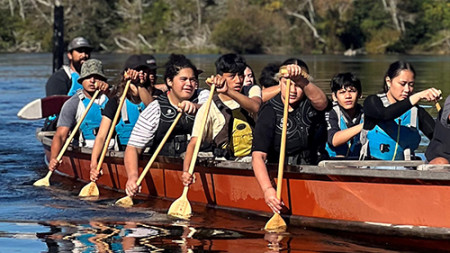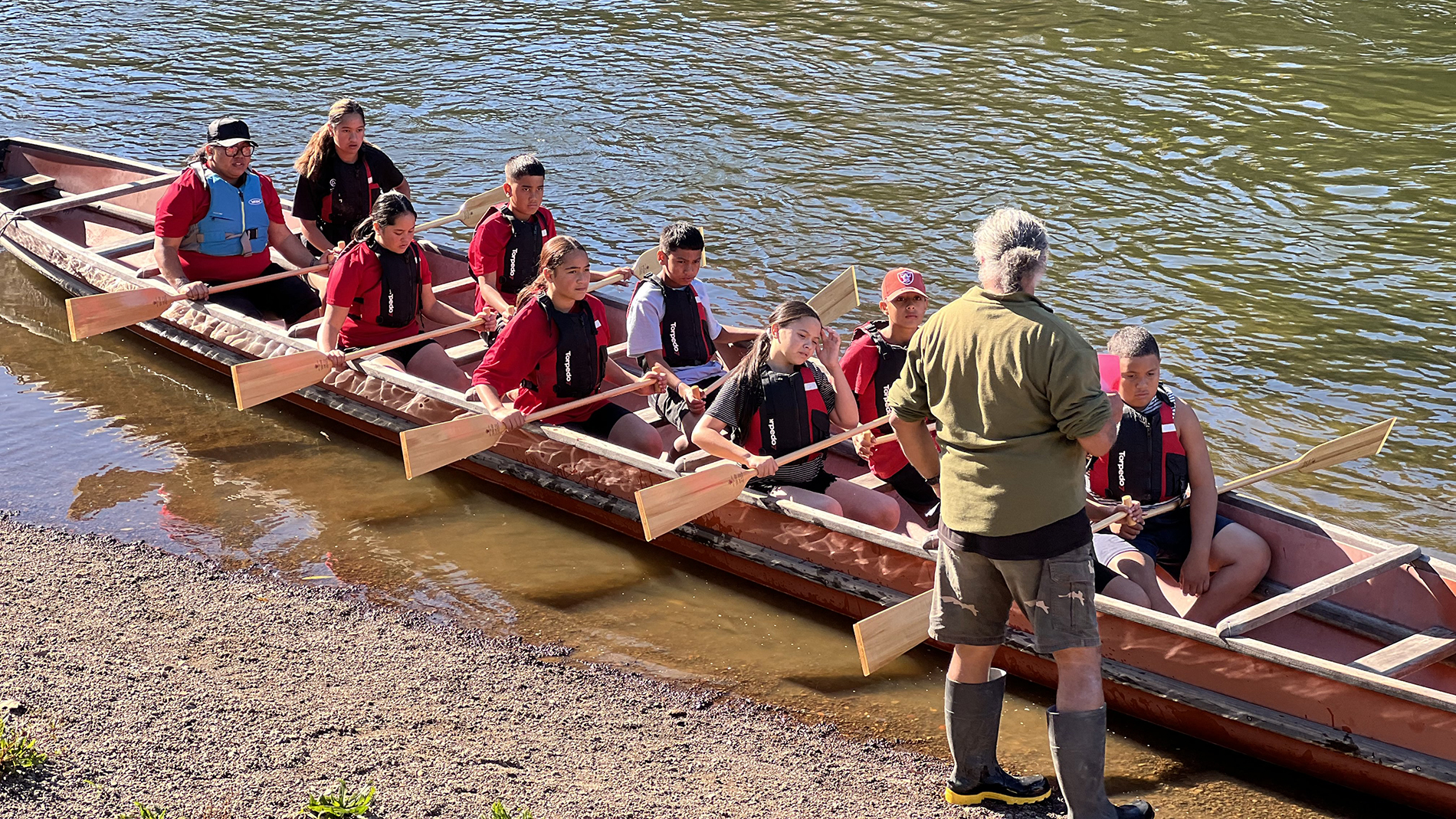“This type of kōrero will help our rangatahi look at what’s been happening and hopefully get them to be advocates for the river, for the environment and for our people.”
– Te Toki Voyaging Trust founder Hoturoa Barclay-Kerr
Tauira from kura in the Waikato are learning to be advocates for the awa and the environment.
A new programme to advance mātauranga Māori in environmental education has been developed by Te Toki Voyaging Trust, and combines waka tētē with mātauranga Māori kaupapa.
Called Kura Waitī, the programme is funded by Waikato Regional Council and has been launched this year, involving seven kura. Wai means water in te reo, and waitī is the star that is connected to fresh water and all the creatures that live in rivers, streams and lakes.
 Te Toki Voyaging Trust founder Hoturoa Barclay-Kerr (Tainui) says Kura Waitī aligns with the values of his trust, which are aroha, whanaungatanga, manaakitanga and kaitiakitanga.
Te Toki Voyaging Trust founder Hoturoa Barclay-Kerr (Tainui) says Kura Waitī aligns with the values of his trust, which are aroha, whanaungatanga, manaakitanga and kaitiakitanga.
“This type of kōrero will help our rangatahi look at what’s been happening and hopefully get them to be advocates for the river, for the environment and for our people.”
“It teaches the importance of the river, of us as a community and us as Māori, and the resources that the awa used to have and once again could supply,” says Hoturoa.
“We connect our rangatahi with some of the traditional ways of doing things, connect them with some of the traditional kōrero of the awa and the environment, how to look after it, what our tupuna used to do with the awa and all those kinds of things.
“Some of the good learnings are understanding that a lot of the trees and anything growing along the banks of our river now are not what used to occupy these spaces and starting to do a look around at how many of our old native plants are still growing here and how they might have been displaced and how we can work towards making that change. It’s about looking at what invasive plant and animal species there are in the river and alongside it that we can see either needs to be controlled or eradicated, and then look at what the traditional types of species, fish particularly, used to be in the river and how we can work towards protecting and enhancing them.”
But before they learn all that science mahi, the students learn waka tētē.
Project lead Turanga Barclay-Kerr says the first session with the tauira, our students, is about how to paddle a waka tētē and water safety.
“We go over the different commands for a waka tētē, how to hold your paddle, how to paddle, how to do a couple of haka specific to the areas where the kura come from,” says Turanga.
“When they come back again, we can go straight into it, straight on the waka and our science mahi, what we’ve planned to do with our awa and environment around here, and for them to be engaged in looking after the place, so for us that’s pretty cool.”
Turanga says getting out paddling while they are learning has “many positives for our tamariki”.
“It gives the kids that feeling of belonging to something good; it’s having a place where the vibe is positive. They can get in with their mates and enjoy something, and get fit at the same time, and having some structure and some things to look forward to, that helps make this kōrero real good and real cool for rangatahi. And it’s something that brings a connection to our past – our history and our kōrero as people of the Pacific, it’s all a part of who we are so being able to do it in this age, that’s real awesome.”
Kaihapa Hotaka Mātauranga Arna Solomon-Banks says the programme came about because the regional council was looking for a meaningful way to support kura with environmental learning in a way that supported te reo, tikanga and mātauranga.
It also aligns with giving effect to Te Ture Whaimana, the Vision & Strategy for the Waikato River.
“Kura Waitī is about engaging our rangatahi in fun ways, hands on, on the awa, learning about the tikanga of waka and the mātauranga, the stories of the awa from the awa people, and sharing that reliving.”
The rangatahi seem to agree it’s fun.
Marcus Corliss, 15, from Te Kopuku High in Hamilton, says his first lesson was “pretty mean”.
“I really liked the team work on the waka, we all encourage each other, that’s pretty mean. I was sitting on Wanganui in the middle where our job is pretty much holding the boat, just pushing and just following each other.
“I learnt that you don’t know everything at the start, but once you get into it you get used to it, it gets pretty easy, it gets pretty good.”
Paeatema Clothier, 14, from Te Kopuku High, says being out on the waka makes her feel good and happy.
“I reckon I’d like to take this back to my whānau at home so that they can come and do this as they grow up and take this along with the whānau they’ll have.”
Kura Waitī is supported by a University of Waikato intern to help promote career pathways for rangitahi in science, technology, engineering, mathematics and mātauranga Māori. That role is funded by the university, Waikato River Authority and the Environmental Research Institute.
The schools taking part in Kura Waiti this year are: Te Whare Kura o Kirikiriroa, Te Whare kura o Bernard Fergusson, Te Kopuku High, Te Whare Kura o Manaia, Te Whare Kura o Maniapoto and Tai Wananga.



